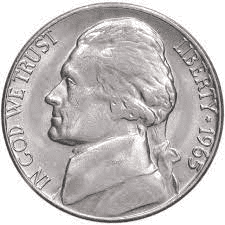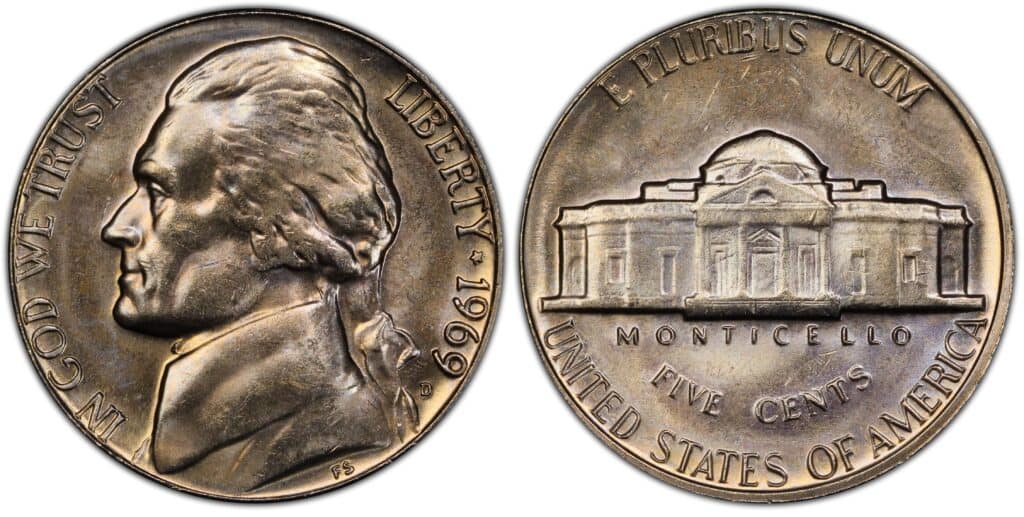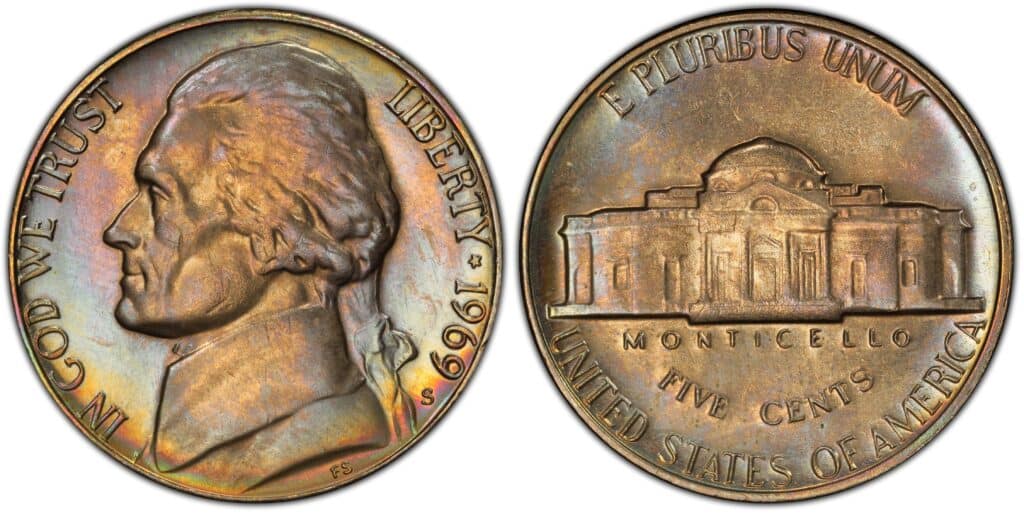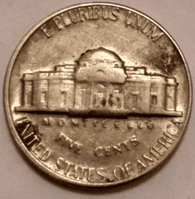What Is A 1969 Jefferson Nickel Made Of?
The 1969 Jefferson nickel is made of 75% copper and 25% nickel. It was designed by Felix Schlag after winning the design contest to honor the third US president and Founding Father, Thomas Jefferson.
For the obverse, a bust of Jefferson is seen. Cornelius Vermeule, an art scholar, noted that the bust looks like the one that Jean-Antoine Houdon sculpted in 1789. This bust of Jefferson would remain unchanged for the five-cent nickel in its 66 years of production.
On the left side of Jefferson, there’s the text, “IN GOD WE TRUST.” On the right side, there’s the text, “LIBERTY” and the year, “1969.” Below the year is the letter that indicates where it is minted.
For the reverse, Schlag originally proposed to have the three-quarters perspective of Monticello, the third president’s mansion. However, the Treasury Department rejected the idea.
Thus, requests for changes were made. The final reverse design was the flat and simple image of Monticello, which was the same design used in the majority of the production.
There are other minute details worth mentioning here. On the reverse side, you’ll find the E. Pluribus Unum motto of the United States, which means “Out of many, one.” Below the mansion image is the text “MONTICELLO.” Below this text is another text that says, “FIVE CENTS.” The lowermost part includes the text, “UNITED STATES OF AMERICA.”
The Denver Mint struck almost 203 million Jefferson nickels. Although quite impressive, it is nothing compared to the 2.8 billion nickels produced in Philadelphia and Denver mints before the 1969 Jefferson nickels were produced.
With the huge production of Jefferson nickels, the coin can easily be found in circulation.
Is A 1969 Nickel Rare?
No, the 1969 nickel isn’t rare. There were a lot of these coins in circulation and finding them is not difficult. The 1969 nickel was produced for almost 50 years.
1969 Jefferson Nickel Varieties
There are different designs made for the 1969 Jefferson Nickel. Thus, it is not surprising to see a lot of its variations. To learn more, here’s a quick look at some of them:
1969 Nickel With No Mint Mark
Metal composition: 75% copper, 25% nickel
Weight: 5 grams

The 1969 Nickel with no mint mark is a nickel coin that doesn’t have any indication of where it was minted. However, it is generally understood that if there’s no mint mark, it is most likely struck in Philadelphia. Of course, this can also be an error where the mint mark was not correctly added.
1969 D Jefferson Nickel
Metal composition: 75% copper, 25% nickel
Weight: 5 grams

The 1969 D Nickel was minted in Denver. There were more than 202 million of these coins produced. The edge is smooth and looks like the other nickels with just minute variations.
1969 S Jefferson Nickel
Metal composition: 75% copper, 25% nickel
Weight: 5 grams

The 1969 S Nickel has the mint mark “S” below the year “1969” on the obverse side of the coin. It means that the coin was minted in San Francisco.
List of errors

Like other minted coins, the 1969 nickel has its fair share of minting errors. The errors may include the wrong punch of the mint mark, double punched letters and numbers, obscure stairs of the Monticello, weak strike resulting in blurry coin details, cracks, and others.
How Much Is A 1969 Jefferson Nickel Worth Today?
The 1969 Jefferson nickel is usually worth 5 cents, which is its face and melt value. However, once it is certified MS+, its value can increase up to $19.
There are extremely rare Jefferson Nickels that are worth hundreds of dollars. To give you an idea, here’s a table that shows you the top 10 most expensive Jefferson nickels.
| Rank | Year | Mint | Worth |
| 1 | 1938 | $1,800 | |
| 2 | 1944 | D | $1,750 |
| 3 | 1943 | D | $1,400 |
| 4 | 1961 | D | $1,300 |
| 5 | 1958 | D | $1,000 |
| 6 | 1939 | $880 | |
| 7 | 1948 | S | $500 |
| 8 | 1946 | S | $475 |
| 9 | 1943 | P | $450 |
| 10 | 1944 | P | $420 |
How Does The Grading System Work?
The Sheldon Scale is used by numismatists to provide a numerical value to coins. The Sheldon Scale goes from poor (P-1) to perfect mint state (P-1) (MS-70). Coins were originally evaluated using words to reflect their condition (Good, Fair, Excellent, Etc.). Unfortunately, coin collectors and dealers had different ideas about what each of these terms represent.
Professional numismatists joined together in the 1970s and established CoinGrading standards. These numismatists now assign grades at key places on the seventy-point scale, using the most regularly utilized numeric points in conjunction with the original adjective grade. The following are the most common coin grades:
-
-
- (P-1) Poor – Indistinguishable and probably damaged; if used, must have a date and mintmark; otherwise, rather battered.
- (FR-2) Fair – Nearly smooth, but without the damage that a coin graded Poor often possesses. The coin must have enough detail to be identified.
- (G-4) Fair – Inscriptions have merged into the rims in some areas, and important elements have been mostly erased.
- (VG-8) Very Good- A little weathered, but all of the primary design elements are visible, albeit faintly. There is little if any, central detail left.
- (F-12) Good – The item is very worn, yet the wear is even, and the overall design details stand out clearly. Rims are almost completely isolated from the field.
- (VF-20) Very Fine – Moderately weathered, with some finer features still visible. The motto or all letters of LIBERTY are readable. Both sides of the coin have entire rims that are separated from the field.
- (EF-40) Extremely Fine – Gently used; all gadgets are visible, and the most important ones are bold. The finer details are bold and clear, however, light wear may be seen.
- (AU-50) Uncirculated – Slight evidence of wear on the coin’s design’s high points; may have contact marks; eye appeal should be adequate.
- (AU-58) Uncirculated Choice – Slight traces of wear, no severe contact marks, almost full mint shine, and great eye appeal.
- (MS-60) Mint State Basal – Strictly uncirculated; no indication of wear on the coin’s highest points, but an unsightly coin with reduced luster, visible contact marks, hairlines, and other flaws.
- (MS-63) Mint State Acceptable – Uncirculated, but with contact scratches and nicks, little reduced shine, but otherwise appealing appearance. The strike is weak to average.
- (MS-65) Mint State Choice – Uncirculated with great mint shine, very little contact blemishes, and exceptional eye appeal. The strike is unusually severe.
- (MS-68) Mint State Premium Quality – Uncirculated with superb luster, no obvious contact marks to the naked eye, and exceptional eye appeal. The strike is quick and appealing.
- (MS-69) Almost Perfect Mint State – Uncirculated with perfect brilliance, a sharp and appealing strike, and extremely good eye appeal. A near-perfect coin with minor imperfections in the planchet, strike, and contact markings (seen only under 8x magnification).
- (MS-70) Mint State Perfect – Under 8x magnification, there are no tiny imperfections discernible; the strike is crisp, and the coin is perfectly centered on a beautiful planchet. Rarely seen on a coin, this coin is bright and whole, with original luster and exceptional eye appeal.
-
Where To Buy Or Sell 1969 Nickels?
There are different places where you can buy or sell 1969 nickels. Since we live in the digital age, the best place to find nickels for sale would be on the Internet. It’s also a great place to sell your nickels.
There are different websites where you can buy or sell 1969 nickels. Some of them include eBay, Amazon, Etsy, and even on social networking sites such as Facebook, Instagram, and Twitter. You can create videos on YouTube as well.
Aside from the Internet, you can visit antique shops, pawnshops, stores, and collectors’ hubs. You can also join clubs of coin enthusiasts and collectors. All these places can help you buy or sell 1969 nickels.
FAQs
Where is the mint mark on a 1969 Jefferson nickel?
The mint mark on a 1969 Jefferson nickel is found just below the year, “1969.” It’s a single letter that tells you where the coin was minted.
Is a 1969 S nickel a proof?
Yes, there are 1969 S nickels that are proof nickels. These nickels are early samples of the 1969 nickels, prepared to check the dies. Most proof nickels are also made as a part of the coin archives.
What does ‘full steps’ mean on a nickel?
Full steps means that a coin has a complete number of steps. In the case of 1969 Jefferson nickel, the Monticello mansion has six steps. If you see a coin complete with these six steps, then you can call that coin full steps.
